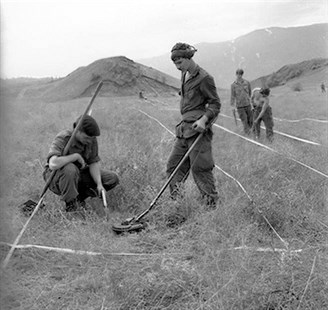
Military personnel scanning for bombs at Cosens Bay, 1973.
Image Credit: Image Courtesy: Vernon Museum and Archives- Photo No. 9933
May 29, 2013 - 7:08 AM
TOO GOOD TO BE TRUE— WHY A VANCOUVER DEVELOPER IS SUING CANADA OVER A PATCH OF WILDERNESS NESTLED IN VERNON, B.C.
The developer thought he was buying 1,349 acres of prime real estate overlooking Kalamalka Lake. Instead, he inherited an unknown quantity of unexploded bombs, mortar shells and grenades left over from military training practices in 1940s Vernon.
Vancouver-based K&L Land Partnership is hesitant to send excavators probing into the ground in preparation for the residential development it once envisioned there.
K&L purchased the land in 2005 as a private sale for $15 million. Since then, it says it invested $13.5 million into the proposed development. They say they never would have bought the property in the first place had they known about the Unexploded Explosive Ordinance (UXO).
K&L is suing the Attorney General of Canada and the Department of National Defense which it claims is lawfully bound to alert prospective purchasers of the risks embedded in the land.
As part of its UXO Legacy Sites program, DND has identified locations across Canada where the unexploded devices are present. The Okanagan itself has a number of locations used for live-fire exercises involving artillery, mortars and tanks. Today's Vernon army camp is only a piece of the land used for military training in the North Okanagan in the Second World War.
Okanagan College history professor Howard Hisdal researches military practices in the Vernon area for some time, and says the area had its heaviest usage from 1940-1945.
"The actual army base is just where the soldiers slept," Hisdal says.
For attack practices, they roamed into what is now known as Coldstream. Hisdal says the area around Cosen's Bay, where K&L's land is situated, was heavily used for military training.
"You have to take soldiers out of the shooting ranges to give them a more realistic experience," Hisdal says. "They'd usually pick a spot at the bottom of a hill and just pound it with mortar—you try to get as many rounds in the air as you can. When they were done, they'd move onto the next hill."
Unfortunately, no daily logs were kept on exactly where shots were fired so it's impossible to know where the unexploded devices might be hiding today. If the mortars landed on their side, they wouldn't have gone off. They'd remain—live and active—buried under the earth until disturbed by a farm animal, an excavator, or a curious hand. Sometimes, they gradually surface on their own. In Europe, they call it the Iron Harvest.
Eight people were killed in the Vernon area, directly attributed to the bombs. In the spring of 1948, three men were killed while loading topsoil into a truck. More than a decade later in 1963, a group of boy scouts discovered an unexploded mortar and, being boys, wanted to investigate. The explosion killed two of them and injured a third. Later, in 1973, two children were killed and two wounded when an explosion erupted near their trailer park. It's believed the accident was caused by a two-inch mortar that went off.
An extensive sweep of the area was conducted by DND in the 1970s, and again in 2005. Still, they can never be 100 per cent sure they've gotten each and every explosive, and a warning on the DND website says no site can ever be declared completely hazard-free.
Hisdal says more deaths were caused by the military tools than by the actual training practices in the 1940s. They conducted the exercises as safely as they knew how, he says.
"Back then, they were seeing 20 or 30 million people dying overseas," Hisdal says. "They weren't thinking about a few bombs going off 70 years later."
With the war now concluded and enclosed in history books, the concern about the unexploded war machines has risen to the top of many minds. In its notice of claim, K&L says the unexploded equipment remain the property and responsibility of Canada. It says the explosives are often buried, leaving users and prospective buyers blind to their presence and to the hazards they pose to life, limb or property.
"The abandonment of Canada's UXO on the Lands is an ongoing unlawful act," the claim says.
In its statement of defense, the government says the possible presence of UXOs in the area is "notorious, a matter of public knowledge in the community of Vernon and its environs, and have been and continue to be widely reported in local and national newspapers." It says K&L knew—or "ought to have known with the exercise of reasonable due diligence"— they were there.
K&L's defense lawyer, Howard Shapray, isn't buying it. In a telephone interview, Shapray said the government has an obligation to sweep the area for unexploded ordinances and alert the public to its presence.
"It's their mess to clean up," Shapray said. "Or alert people, or a combination of both. Or pay them the damages."
To contact the reporter for this story, email Charlotte Helston at chelston@infotelnews.ca or call (250)309-5230.
News from © iNFOnews, 2013